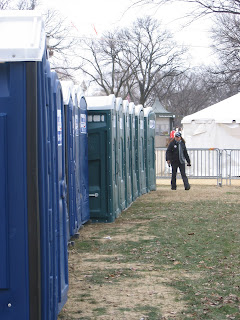
I had planned to write a post yesterday, but came into the museum and there was some kind of bizarre power outage that seems to have been localized to my office. I was in the middle of writing when zap both computer and lights went out. It took the electricians awhile to remedy the situation, so I gave up my effort for the day. Both artists remained valiantly at work, however.
Poor António nearly froze to death Friday night when I walked the artists to Fádo’s, a local pub, for happy hour. The last time I walked there it was warm, and hadn’t seemed nearly so far! But, he came to work first thing Saturday morning and got right to work laying out his large wall “fresco” – the installation he is creating in the gallery on the wall opposite Aimé’s. The only glitch came up today, however. After I left the museum yesterday, António grew the installation about 6-8 feet wider than we had previously discussed. So, today, I ran around making sure it wouldn’t be a security issue to have the exposed metal and other elements of his installation so close to the edge of the platform where visitors could touch them. It’s all worked out in the end, and António’s artistic vision will remain uncompromised.
Aime has made a lot of progress with his wall, as well. The first word he painted on it is “dialogue.” I will have to ask him about it, or better yet – you ask him! This blog is meant to be interactive! Please send any kind of questions or comments…
And, for the picture today, rather than sending an update of the artists at work, I’ve decided to upload a scene of what’s going on around us on the mall. People are everywhere, and so are port-a-potties. I believe some 5,000 port-a-johns have been delivered to the mall, although I have no idea how accurate this number is. All I can attest to is that there are a lot.
Poor António nearly froze to death Friday night when I walked the artists to Fádo’s, a local pub, for happy hour. The last time I walked there it was warm, and hadn’t seemed nearly so far! But, he came to work first thing Saturday morning and got right to work laying out his large wall “fresco” – the installation he is creating in the gallery on the wall opposite Aimé’s. The only glitch came up today, however. After I left the museum yesterday, António grew the installation about 6-8 feet wider than we had previously discussed. So, today, I ran around making sure it wouldn’t be a security issue to have the exposed metal and other elements of his installation so close to the edge of the platform where visitors could touch them. It’s all worked out in the end, and António’s artistic vision will remain uncompromised.
Aime has made a lot of progress with his wall, as well. The first word he painted on it is “dialogue.” I will have to ask him about it, or better yet – you ask him! This blog is meant to be interactive! Please send any kind of questions or comments…
And, for the picture today, rather than sending an update of the artists at work, I’ve decided to upload a scene of what’s going on around us on the mall. People are everywhere, and so are port-a-potties. I believe some 5,000 port-a-johns have been delivered to the mall, although I have no idea how accurate this number is. All I can attest to is that there are a lot.




No comments:
Post a Comment